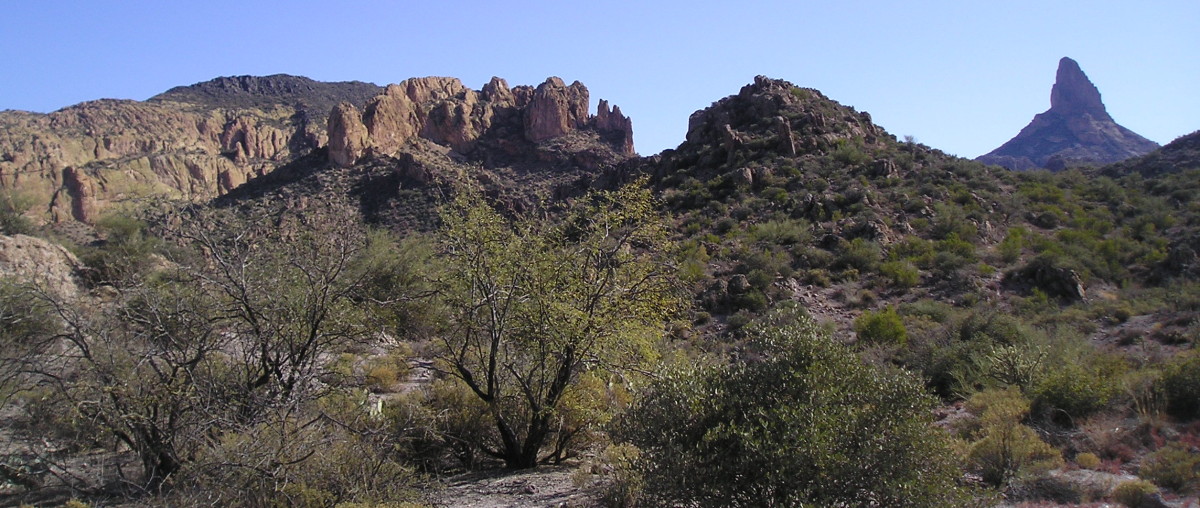- Written by Bradley Cooper
Under a cloudless sky, skirting eastward along Boundary Cone Road we head toward the green tinted Ute Mountains waiting in the distance. The heavy rains that inundated the southwest a few weeks ago have produced spectacular spring foliage, and the yellow flowers splashing against the lush green carpet of undergrowth is quite breathtaking.
Usually the dominant colors along this stretch are black and brown with dashes of fractured red strata. This spring is much different, however. Even the tailings from long abandoned gold mines that once dotted the nearby hillsides are decorated with vibrant shades of yellow and green.
It is shortly after 1 p.m. Our destination is the ghost town of Oatman, Arizona. Albeit a dusty one, Oatman is indeed a jewel to behold.
Known today as a route 66 roadside tourist attraction, this town was once a bustling mining town with mercantile, saloons, brothels, and an array of questionable personalities. And yes, those mischievous but ever so lovable burros you’ve heard so much about have called Oatman home since the days of the Spanish miners, dating back hundreds of years.
Even before the Spanish arrived, numerous native Indian tribes dominated the nearby Colorado River basin, and sometimes skirmishes erupted. In fact, the town of Oatman is believed to have been named after a young girl who survived an ambush by the native Indians. The rest of her family was less fortunate.
Her name was Olive Ann Oatman. Around 1853 Olives’ mother and father gathered up all seven children and departed their modest home in Illinois, joining a wagon train destined for the Colorado River. All did not go as planned. After a time the wagons split up, and soon the Oatman family found themselves alone in dangerous territory. Indeed, on February 18th, 1851 the family was savagely attacked. Everyone in the party was killed except for Olive, her sister Mary, and a brother, Lorenzo, who was thrown into a ravine and left for dead. Olive and Mary were tattooed by their captors and held as slaves near the current town of Congress Arizona before being sold to a Mohave chief near the modern location of Needles California. The sisters endured years of abuse, and Mary eventually died from starvation.
During the winter of 1855, the army learned of young Miss Oatmans’ ordeal and began negotiations to free her. On February 28, 1856, wearing a bark skirt and able to speak little English, Olive was traded for a horse, blankets, and beads, after which she was re-united with her long lost brother Lorenzo.
Olive eventually married and adopted a daughter, but she was never able to completely leave the experience behind her. In fact, it is believed that for the rest of her life she kept a jar of hazelnuts, a Mohave staple, as a reminder of her years with the Indians. Olive died March 20th, 1903 and is buried in Sherman Texas.
The town of Oatman, located in the Black (Ute) Mountains fourteen miles east of the Colorado River in northwest Arizona, was officially recognized as a town when a post office was established in 1905, following the discovery of the Vivian mine in 1902. The Vivian mine was discovered by Ben Taddock, who reportedly spotted free gold glittering along a ledge and immediately filed for a claim. Taddock then sold the mine to Judge E.M. Ross and Thomas Eqing, who in turn sold it to the Vivian Mining Company. During the period between 1904 and 1907 the mine yielded over three million dollars worth of gold. As the Vivian began to play out, other mines were discovered in the area, including the Tom Reed, and eventually the Leland, the Mitchell, the Snowball, the Treadwell, Gold Road, Blue Ridge and many more. In fact, the Oatman gold mining district was among the most productive sources of gold in the United States.
Even Hollywood has had affairs with Oatman.
On March 29, 1939 Clark Gable and Carole Lombard married in Kingman, Arizona. Having film commitments, the couple then headed back to Los Angeles via Route 66, stopping for the night at the Oatman Hotel. The Hotel still stands, but rooms are no longer available. Instead, it has become a free museum, offering visitors the opportunity to view the refurbished Gable & Lombard suite upstairs, and enjoy the authentic feel of the old west in the saloon and restaurant downstairs.
Oatman has also been featured in several Hollywood westerns, including Foxfire (1955), Edge of Eternity (1959) and How the West Was Won (1962).
As my wife and I wind our way up Route 66 into town, we are greeted by a menagerie of shops and shopkeepers, colorful people pitching their wares to colorful people purchasing them. Cowboys, hippies, artists, bikers and a plethora of blue haired visitors, all happily sharing the narrow, dusty streets with a handful of comedic, but accommodating burros. Oatman is indeed a charming stop along the old road… part ghost town, part open air marketplace. My wife eyes a summer dress while I purchase a coffee mug emblazoned with the words ‘Historic Route 66’. We buy ourselves each a scoop of ice cream and we wander through town aimlessly, laughing as a crowd gathers to watch the antics of a burro that has stolen a loaf of bread from the back seat of an open, parked convertible. After all, this is what it’s all about, isn’t it? I mean, if one were actually able to explain in words what “it” is all about, that explanation would not be complete without mention of Oatman, Arizona.



